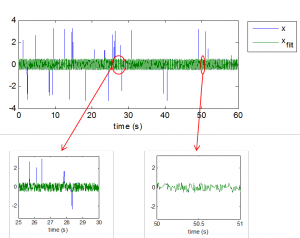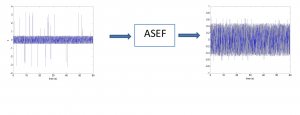ASEF Algorithm
Algorithm for removing peak and spike artifacts based on a threshold built on the analytic signal envelope.
The ASEF algorithm with an example of application can be found here
The paper describing ASEF can be found here.
This software was jointly developed with Dept IIE of LLeida University.
ASEF algorithm is currently maintained by the B2SLab at UPC, so please send us a note if you have any suggestion or comment.
Please cite the following paper when using ASEF algorithm in your research:
Melia U., Clariá F., Vallverdu M., Caminal P. (2014) “Filtering and Thresholding the Analytic Signal Envelope in order to improve Peak and Spike Noise Reduction in EEG Signals.” Medical Engineering & Physics. 36(4):547–553.
ABOUT ASEF
The ASEF algorithm reduces the amplitude of peaks or spikes in any kind of signals. Firstly, the envelope m(t) of a signal x(t) is filtered using a low-pass filter with a pass band BAM, then a threshold Th(t) based on the filtered envelope mfilt(t) is defined and finally this threshold is applied to the envelope m(t). This Th(t) is calculated at each time sample of mfilt(t) as Th(t)=mfilt(t)+k Mfilt , where Mfilt is the mean value of mfilt(t) and k is an arbitrary constant.
The main steps of the proposed filter algorithm applied to a signal x(t) are:
1) Calculation of the analytic signal of x(t).
2) Calculation of the envelope m(t) and the instantaneous phase ϕ(t).
3) Filtering of the m(t) by using a FIR filter with a cut off frequency BAM in order to obtain mfilt(t).
4) Thresholding the filtered envelope in order to preserve the samples that satisfy m(t) < Th(t), in this way mTh(t) = mfilt(t)+k Mfilt if m(t) > Th(t) otherwise mTh(t) =m(t) .
5) Multiplication of the filtered envelope mTh(t) by cosϕ(t) , in order to obtain the final filtered signal xfilt(t).
 This algorithm removes all or part of the peaks or spikes (depending on k value of Th(t) ) in the original signal x(t), preserving its frequency information.
This algorithm removes all or part of the peaks or spikes (depending on k value of Th(t) ) in the original signal x(t), preserving its frequency information.
For more details see the published article.
The optimum parameter BAM and k were estimated for EEG signals in this publication.
By changing these parameters ASEF algorithm can be applied to any kind of digital signals.
Contacts
Umberto Melia
Email: umberto.melia@ upc.edu
Address:
Universitat Politècnica de Catalunya, dept. ESAII
c/ Pau Gargallo 5, 08028 Barcelona, Spain
Tel.: +34 93 407 07 73

